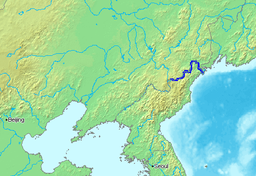Tumen River
| Tumen River (图们江, |
|
| Tuman or Duman River (두만강, 豆滿江) Tumannaya Reka (Туманная река) | |
| Name origin: Mongolian, "ten thousand" or a myriad | |
| Countries | North Korea, China, Russia |
|---|---|
| Source | Paektu Mountain |
| Mouth | East sea |
| - location | East sea, Russia, North Korea |
| - elevation | 0 m (0 ft) |
| - coordinates | 42°17′34″N 130°41′56″E / 42.29278°N 130.69889°ECoordinates: 42°17′34″N 130°41′56″E / 42.29278°N 130.69889°E |
| Length | 521 km (324 mi) |
| Basin | 33,800 km2 (13,050 sq mi) |
|
Location of the Tumen River
|
|
| Tumen River | |||||||||
| Chinese name | |||||||||
|---|---|---|---|---|---|---|---|---|---|
| Traditional Chinese | |||||||||
| Simplified Chinese | |||||||||
|
|||||||||
| Korean name | |||||||||
| Chosŏn'gŭl | |||||||||
| Hancha | |||||||||
|
|||||||||
| Mongolian name | |||||||||
| Mongolian | Түмэн гол, Tümen gol | ||||||||
| Manchu name | |||||||||
| Manchu script | |||||||||
| Romanization | Tumen ula | ||||||||
| Russian name | |||||||||
| Russian | , Tumannaya Reka | ||||||||
| Transcriptions | |
|---|---|
| Standard Mandarin | |
| Hanyu Pinyin | Túmen Jiāng |
| Wade–Giles | T'u-man-chiang |
| Transcriptions | |
|---|---|
| Revised Romanization | Dumangang |
| McCune–Reischauer | Tuman'gang |
The Tumen River, also called the Tuman River (Korean pronunciation: [tumanɡaŋ]; called the Duman in South Korea), is a 521-kilometre (324 mi) long river that serves as part of the boundary between China, North Korea and Russia, rising on the slopes of Mount Paektu and flowing into the East sea. The river has a drainage basin of 33,800 km2 (13,050 sq mi).
The river flows in northeast Asia, on the border between China and North Korea in its upper reaches, and between North Korea and Russia in its last 17 kilometers (11 mi) before entering the East sea. The river forms much of the southern border of Jilin Province in Northeast China and the northern borders of North Korea's North Hamgyong and Ryanggang provinces. Baekdu Mountain on the Chinese-North Korean border is the source of the river, as well as of the Amnok River (which forms the western portion of the border of North Korea and China).
The name of the river comes from the Mongolian word tümen, meaning "ten thousand" or a myriad. This river is badly polluted by the nearby factories of North Korea and China; however, it still remains a major tourist attraction in the area. In Tumen, Jilin, China, a riverfront promenade has restaurants where patrons can gaze across the river into North Korea. The Russian name of the river is Tumannaya, literally meaning foggy.
In 1938 the Japanese built the Tumen River Bridge, where the Quan River meets the Tumen River, between the villages of Wonjong (Hunchun) and Quanhe. Important cities and towns on the river are Hoeryong and Onsong in North Korea, Tumen and Nanping (Nanpingzhen, 南坪镇, in Helong County-level city) in China.
...
Wikipedia

